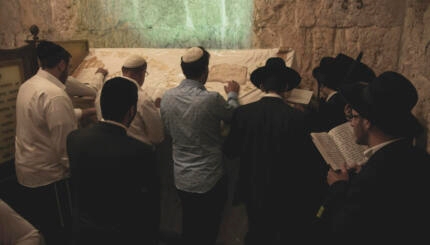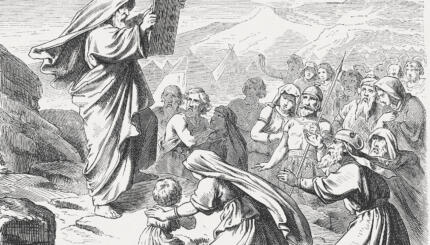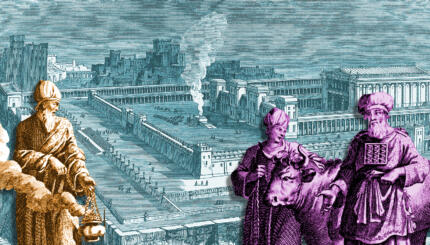Reprinted with the author’s permission from Jewish Law: History, Sources, Principles (Jewish Publication Society).
The appearance of a comprehensive code naturally stimulates the composition of a literature of commentaries that seek to probe the code’s comprehensiveness, accuracy, and other qualities. The high esteem in which Maimonides’ Mishneh Torah was held, on the one hand, and the sharp controversy it engendered, on the other, sparked the creation of an extensive and voluminous literature of commentary.
These commentaries had various objectives: some to criticize Maimonides, others to defend him against the critics, or to explain or supplement his treatment of particular subjects. The central function of most of the commentaries, particularly the earlier ones, was to trace the talmudic sources from which Maimonides distilled his halakhot.
No other halakhic work has had the distinction of being the subject of so many commentaries; indeed, commentaries on the Mishneh Torah are still being written. Some of the commentaries are usually printed on the pages of the Mishneh Torah. They include:

Help us keep Jewish knowledge accessible to millions of people around the world.
Your donation to My Jewish Learning fuels endless journeys of Jewish discovery. With your help, My Jewish Learning can continue to provide nonstop opportunities for learning, connection and growth.
Migdal Oz by Shem Tov ibn Gaon
Shem Tov ibn Gaon, Rashba’s disciple, was a Spanish halakhic authority and kabbalist of the mid-fourteenth century. He was the first to supply source references for Maimonides’ text, and he also included references to Maimonides’ responsa. His main objective was to defend Maimonides and counter Rabad’s criticisms. He also corrected scribal errors in the text.
Maggid Mishneh by Vidal of Tolosa
Vidal of Tolosa, a colleague of Nissim Gerondi (Ran), was a leading Spanish halakhic authority in the fourteenth century. His goals in Maggid Mishneh were to explain Maimonides’ text, to indicate the halakhic sources, to suggest reasons why Maimonides preferred the views he adopted over those he rejected, and to defend Maimonides against his critics, especially Rabad.
Unlike the author of Migdal Oz, Vidal did not always agree with Maimonides, but at times was inclined to accept the opinion of Rabad or of other critics. Maggid Mishneh is extant on six of the fourteen books of the Mishneh Torah.
Kesef Mishneh by Joseph Caro
Joseph Caro, the author of the Shulhan Arukh, wrote a comprehensive commentary on the Mishneh Torah, entitled Kesef Mishneh. His aims were largely similar to those of the Maggid Mishneh, which he often cited and discussed. His commentary also covers books of the Mishneh Torah for which Maggid Mishneh is lacking.
Yekar Tiferet by David ibn Zimra (Radbaz)
Radbaz, the foremost halakhic authority of the sixteenth century in Egypt (until he immigrated to the Land of Israel), provided a commentary on the portion of the text of Maimonides for which there was no Maggid Mishneh. He defended Maimonides against criticism but did not particularly concern himself about supplying source references. Parts of his commentary have been printed in several recent editions of works by Maimonides, as well as separately.
Lehem Mishneh by Abraham di Boton
Abraham di Boton, a leading halakhic authority in Salonika in the sixteenth century, was a disciple of Samuel de Medina (Maharashdam). His book Lehem Mishneh attempts to ascertain Maimonides’ sources and reconciles inconsistencies between the Mishneh Torah and the talmudic sources.
When he was in the midst of his commentary to Hilkhot Tefillah [Laws of Prayer], Caro’s Kesef Mishneh reached him, and he found in it explanations and novellae similar to those he had also written. He therefore decided that for the rest of his commentary, "I will write down only those points of mine that are novel," i.e., only comments adding to what was said by Caro.
Mishneh la-Melekh by Judah Rosanes
Judah Rosanes lived in the second half of the seventeenth and the early part of the eighteenth centuries. He was the Rabbi of Constantinople and was regarded as the leading Turkish halakhic authority of his generation.
His book Mishneh la-Melekh is different from the other commentaries. If, for purposes of comparison, we distinguish between commentaries and novellae, the books above referred to would be classified as commentaries, whereas Mishneh la-Melekh would be novellae.
Judah Rosanes actually wrote his novellae without reference to Maimonides, as a work on various talmudic subjects, but his disciple, Jacob Kuli, who printed his books, arranged them to correspond to the organization of the Mishneh Torah.
Haggahot Maimuniyyot by Meir ha-Kohen of Rothenburg
Haggahot Maimuniyyot [Maimonidean Glosses] by Meir ha-Kohen of Rothenburg is different in kind and purpose from all the other commentaries previously mentioned, which is why it is discussed last although it was composed before some of the others.
The author lived at the end of the thirteenth and the beginning of the fourteenth centuries and was a disciple of Maharam of Rothenburg. The purpose of Haggahot Maimuniyyot was not to criticize or defend Maimonides, or to find his sources, but to supplement the Mishneh Torah with the responsa and decisions of the German and French halakhic authorities wherever appropriate.
Only a few of the hundreds of commentaries that are part of the extensive literature on Maimonides’ Mishneh Torah have been discussed here. In addition to the commentaries directly on the Mishneh Torah, there are discussions of laws as set forth by Maimonides interspersed throughout the general literature of commentaries, novellae, and responsa.


